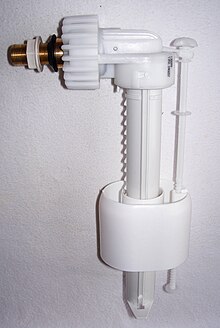浮球阀
外观

浮球阀是厕所水箱、水塔等储水器中用来进水的自动开关。当水箱中的水位低于规定位置时,浮球阀自动打开,让水进入水箱;当水位达到规定位置时,浮球阀自动关闭,停止进水。[1]浮球阀由墨西哥神父兼科学家何塞·安东尼奥·德·阿尔萨特·伊·拉米雷斯发明,他于1790年在《墨西哥文学杂志》(Gaceta de Literatura Méxicana)中描述了浮球阀[2]。1797年,埃德蒙·卡特赖特为蒸汽机中的浮球阀申请了专利[3][4]。
参考文献
[编辑]- ^ 周斌兴,刘文花主编. 最新实用五金手册. 郑州: 河南科学技术出版社. 2015: 353. ISBN 978-7-5349-6333-9.
- ^ Saladino García, Alberto. El sabio: José Antonio Alzate y Ramírez de Santillana (Toluca, UAEM, 2001), PP. 42-43.
- ^ The Repertory of Arts and Manufactures: Patent Inventions: And Other Discoveries and... Volume 10. London. 1799: 1–5 [5 November 2017].
- ^ What is a Ballcock?. wisegeek.com. [5 November 2017].
外部链接
[编辑]- Introduction to ballcock valves
- US 2837111,Mueller, Paul G.,“Ball cock valve mechanism”,发表于6 January 1955,发行于3 June 1958; hysterisis issue. "Such flush tank valves as now commonly used are closed against the pressure of water from a source of supply which pressure opposes the movement of the float under rising water level in the tank. This results in a slow or delayed movement of the valve preliminary to its reaching its fully closed position and accordingly develops an objectionable hissing sound due to the discharge of water through the then slightly open valve under full water pressure; this delayed action continuing until the slowed delivery of water to the tank finally raises the water level to a point where the float will be effective in fully closing the valve. This action of the conventional float controlled valves frequently gives rise to a condition where full closing of the valve does not occur with a consequent continuous leakage of water through the valve with a resulting waste of water."
- US 418162,Cahill, W. J.,“Ball cock”,发表于2 October 1889,发行于31 December 1889; hysterisis issue.
